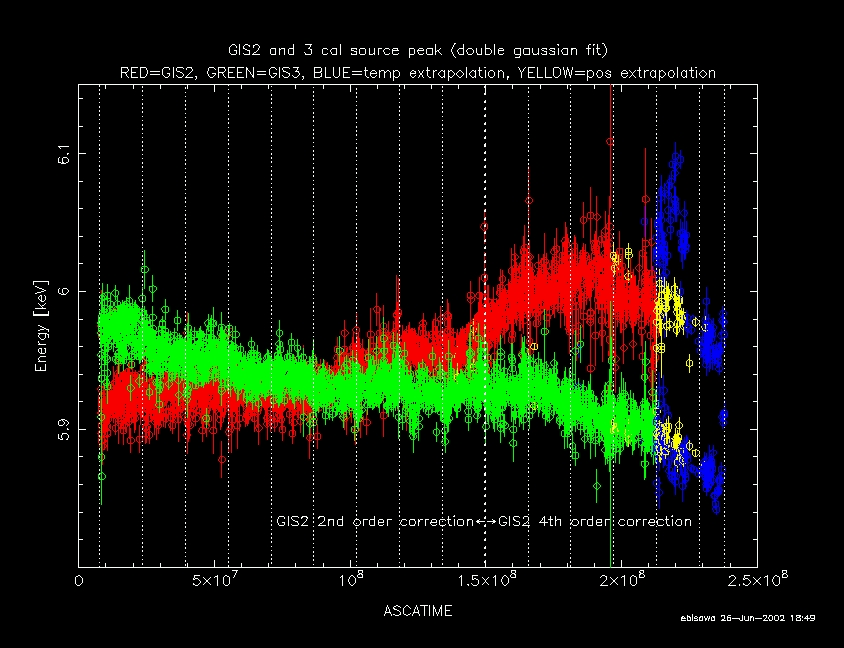Status of the Latest GIS Gain Determination
Updated 2002-6-26
This is an update of the page posted on 2001 April 10, in two respects:
- 60 additional sequences have been reprocessed, using the final gain calibration file. The GIS data for these sequences in Rev 2 public archive used an extrapolation of the gain history, and no updates were made in 2001 April.
- We provide a new reprocessing of the GIS event data for all 106 sequences that were reprocessed in 2001 April, to correct for a minor bug in the v4.3.24 gain calibration file that was used in 2001 April (but not in the official Rev2 archive). This results in +0.17% and -0.25% changes in the pha-gain relationships for GIS-2 and GIS-3, respectively, at 1-CCD mode nominal position.
The GIS long term gain variation had been regularly monitored by the GIS team and the data processing team. Calibration of the long term gain variation by the GIS team is reflected in the gain determination parameters, which are written in the gis_temp2gain.fits calibration file (the final version -- v4.3.25 -- is found at ftp://heasarc.gsfc.nasa.gov/asca/data/gis_reprocess_2002-June/gis_temp2gain.fits). Please see the "Status of the GIS Gain Calibration" page for details.
As of June 2002, in the current ASCA archives (revision 2), there are 166 sequences in which GIS gain was determined by extrapolation of the gain parameters. Calibration source peak energies are determined in the processing, but the automated model fitting is not always successful. Due to these reasons, the calibration source energies determined in the processing show large scatterings for recent data, which does not reflect the actual rather stable performance of the GIS instrument.
The following figure shows the calibration source peak energies determined from the calibration source spectral files in the rev2 archives, but the model fit is correctly performed (red=GIS2, green=GIS3). For the data points indicated with yellow, the gain is determined by extrapolation of the positional correction parameters. For the points indicated with blue, the gain is determined by extrapolation of both the positional and temperature correction parameters. The vertical dotted lines indicate the times when the positional gain parameters are updated. Note that gain extrapolation is not always precise, therefore we see large scatterings from time to time for extrapolated data.
The psfile, QDP file of this figure are available.

Here is a list of the REV2 sequences in which GIS gain is determined with extrapolation. Using the latest and final gis_temp2gain.fits file (version 4.3.25), we have reprocessed GIS event files of these sequences, so that the gain is determined by interpolation. (the method is explained at the bottom of the Status of the GIS Gain Calibration page). The reprocessed GIS events are available at ftp://heasarc.gsfc.nasa.gov/asca/data/gis_reprocess_2002-June. In the following figure, we show GIS cal source peak energies for all the data (those currently reprocessed ones and the data in the archives) for which gain is determined by interpolation. The psfile and QDP file (only for reprocessed data) are also avialble.

Comparing the two figures above, we see that the scattering of the gain peak energies becomes significantly smaller when the gain is determined by interpolation using the latest gis_temp2gain.fits file. For energy sensitive data analysis of those sequences for which gain was originally determined by extrapolation, we recommend to use the reprocessed GIS event lists presented here, instead of the ones in the REV2 archives.
ASCA GOF is planning to reprocess all the ASCA data and complete the final ASCA archives (rev3 processing), once all the instrumental calibrations (GIS, SIS, attitude etc) are finalized. Untill then, those GIS event files for which gain is determined by interpolation (those newly reprocessed at ftp://heasarc.gsfc.nasa.gov/asca/data/gis_reprocess_2002-June and others sequence in REV2 archives ) represent the currently best-calibrated GIS datasets.
If you have any questions concerning ASCA, visit our Feedback form.

